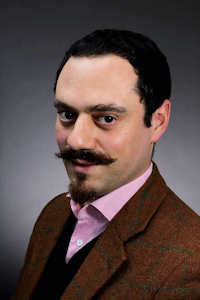|
|
Roland W. FlemingKurt Koffka Junior Professor Of Experimental Psychology, Roland W. Fleming is the 2013 winner of the VSS Young Investigator Award. Roland is the Kurt Koffka Junior Professor of Experimental Psychology at University of Giessen in Giessen, Germany. His work combines deep insight about perceptual processes with rigorous experimentation and computational analysis, and he communicates his findings with exemplary clarity. Roland is well-known for his transformative work connecting the perception of object material properties with image statistics. Equally important is his work on shape estimation from ‘orientation fields’, which has been widely appreciated for highlighting raw information in the image that is diagnostic of 3D shape. Roland has also applied insights from perception to the advancement of computer graphics. He takes an interdisciplinary approach that combines neural modelling, psychophysical experiments, and advanced image synthesis and analysis methods. In addition to his formidable array of intellectual contributions, Roland has been a tireless contributor to the academic community, serving on editorial boards, organizing symposia and short courses, and training first rate students and postdocs. |
Dr. Fleming’s presentation:
Shape, Material Perception and Internal ModelsMonday, May 13, 1:00 pm, Royal Palm Ballroom When we look at objects, we don’t just recognize them, we also mentally ‘size them up’, making many visual inferences about their physical and functional properties. Without touching an object, we can usually judge how rough or smooth it is, whether it is physically stable or likely to topple over, or where it might break if we applied force to it. High-level inferences like these are computationally extremely challenging, and yet we perform them effortlessly all the time. In this talk, I will present research on how we perceive and represent the properties of materials and objects. I’ll discuss gloss perception and the inference of fluid viscosity from shape cues. Using these examples I’ll argue that the visual system doesn’t actually estimate physical parameters of materials and objects. Instead, I suggest, the brain is remarkably adept at building ‘statistical generative models’ that capture the natural degrees of variation in appearance between samples. For example, when determining perceived glossiness, the brain doesn’t estimate parameters of a physical reflection model. Instead, it uses a constellation of low- and mid-level image measurements to characterize the extent to which the surface manifests specular reflections. Likewise, when determining apparent viscosity, the brain uses many general-purpose shape and motion measurements to characterize the behaviour of a material and relate it to other samples it has seen before. I’ll argue that these ‘statistical generative models’ are both more expressive and easier to compute than physical parameters, and therefore represent a powerful middle way between a ‘bag of tricks’ and ‘inverse optics’. In turn, this leads to some intriguing future directions about how ‘generative’ representations of shape could be used for inferring not only material properties but also causal history and class membership from few exemplars. |
|

